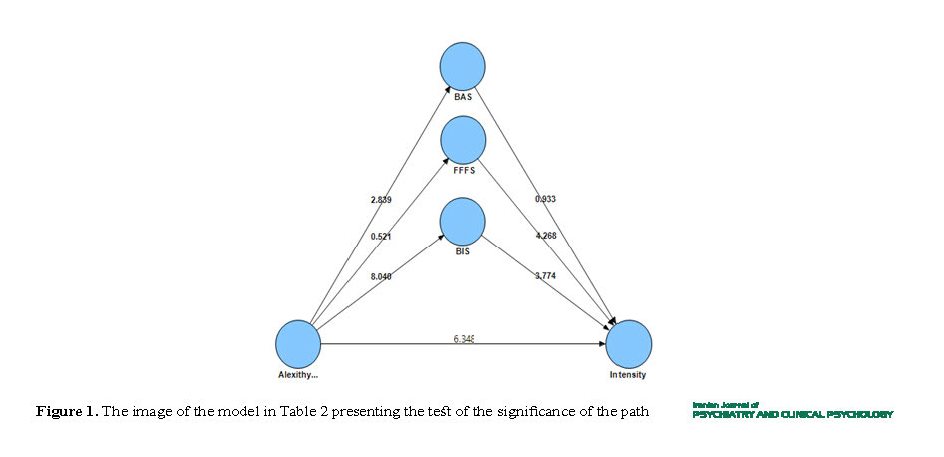BibTeX | RIS | EndNote | Medlars | ProCite | Reference Manager | RefWorks
Send citation to:
URL: http://ijpcp.iums.ac.ir/article-1-2806-en.html
2- PhD. in Clinical Psychology, Professor, Department of Psychology, Faculty of Psychology and Education, University of Tehran, Tehran, Iran. ,
3- PhD. in Psychology, Associate Professor, Department of Clinical Psychology, Faculty of Psychology and Educational Sciences, Allameh Tabatabaee University, Tehran, Iran.
4- PhD. in Psychometrics, Assistant Professor, Department of Psychology, Faculty of Humanities, Tarbiat Modares University, Tehran, Iran.
Extended Abstract
1. Introduction
hronic pain refers to a continuous pain lasted for at least 3 months. It is common among adults and causes problems for an individual’s health and the quality of life. According to studies, the patient with chronic pain perceives their pain with a higher intensity. One of the most important factors that affects the severity and duration of pain is alexithymia. People with alexithymia cannot understand their emotions well, struggle to express their emotions to others, and their thinking is operational. So, they externalize their emotion with physical signs like chronic pain. This externalization is not only the result of their personality but has some physical root, too.
Many studies indicate that these people express a lot of avoidance in their actions, but no study has studied the role of brain behavioral systems, especially the behavioral inhibition system in this phenomenon. We postulate in our study that behavioral inhibition system has a mediating role in the relationship of chronic pain with alexithymia and that the avoidance behavior in patients with chronic pain is not just a response to the pain, but it may have a significant role in their brain behavioral systems.
2. Method
The present study design was correlational and was carried out with a structural equation modeling approach. The statistical population was all 20-60 years old patients with chronic pain who had referred to the Mahan Clinic and the physical medicine and rehabilitation clinic of Arman in Tehran, from spring to autumn of 2017. Out of them, 488 patients (258 women, and 182 men) who reported the chronic musculoskeletal pain for at least 3 months, were chosen purposefully. They were asked to complete the study questionnaires. The analysis was done in SmartPLS software.
The first study tool was Numeric Rating Scale (NRS). It is a visual rating scale for assessing the intensity of pain by asking the patients to choose a number between 0 and 10 for the intensity of their pain. The second study tool was Toronto Alexithymia Scale (TAS-20). It has 20 questions and scored on a 5-point Likert-type scale, from 1 (Completely disagree) to 5 (Completely agree). The scale reveals three factors: difficulty in identifying feelings, difficulty in describing feelings, and externally-oriented thinking. The reliability and validity of the Persian version of this scale have been assessed by Besharat [48].
The psychometric properties of this scale were confirmed in that research. The third study tool was the inhibition/activation system scale. It assesses the Behavioral Activation System (BAS) and the Behavioral Inhibition System (BIS). The scale has 24 items and is scored based on a 4-point Likert-type scale (from 1 to 4). Factor analysis confirmed the psychometric properties of the scale. In Iran, the psychometric properties of the Persian version of this scale were also assessed on different groups and confirmed, too. Following the Heim et al. study [50], we used this scale for three subscales instead of two, after doing a factor analysis and finding a group of questions in accordance with Fight/Flight System (FFS).
3. Results
Table 1 presents the correlations of the study variables. The model was assessed with SmartPLS because we had a variable (intensity of pain) with one question. To assess the reliability of the model, using Cronbach alpha, communality, and the composite reliability was appropriate. To assess the validity of the model, we eliminated the questions with factor load below or near to 0.7 based on Churchill approach [55]. The Average Variance Extracted (AVE) was more than 0.5, and also less than the composite reliability. The cross-loading test and Fornell-Larcker test for divergent validity were appropriate, too. Figure 1 displays the model. Table 2 presents the test of the significance of the path shown.
To illustrate the moderating role of brain behavioral system, we used the Sobel test that proved the moderating role, just for BIS, between alexithymia and pain intensity (Zs=3.416, β=0.049, P=0.000). We used the Goodness of Fit (GOF) to assess the quality of the model. The result was GOF=√average (communality)*R^2=0.400. This quality compared with three values (0.19, 0.33, 0.67) set by Chin [55], was rated upper than average.
4. Discussion
The results of this research showed that the relation between alexithymia and pain intensity is positive and significant. It also confirms the first hypothesis of the study and is consistent with previous studies results [2-5]. The similar results might be explained as follows: the patients with alexithymia may have hypersensitivity to physical sensations and express long-term responses to pain because of some deficit in their emotion regulation system. This may be a mechanism that connects the alexithymia to chronic pain [19]. Also, the defect in the ability of the symbolization of emotions may cause problems such as abnormal physical reactions and disability in self-control and self-regulation [7]. This may also affect the intensity and duration of the pain that is comprehended.
The results of this study indicate that the behavioral inhibition system has a mediator role between alexithymia and the intensity of pain that is perceived by the people as chronic pain. Considering the partial role of this mediator, we can conclude that some part of the relationship between alexithymia and the intensity of pain, is mediated through behavior inhibition system. There is also this probability that the neural machinery in alexithymia is activated more at the physiological level, and less at the cognitive-experiential domains of the emotional response system [19]. Briefly, alexithymia as a disability to recognize and state the emotions as well as a tendency to think objectively can increase the activity of inhibition system, resulting in expression of some kind of avoidance or inhibition behavior. Whenever the alexithymia is accompanied by the increase of activity in the behavioral inhibition system, the chronic pain is felt with more intensity.
Ethical Considerations
Compliance with ethical guidelines
In this research, the form of ethical considerations was filled by the patients and was followed by the researchers.
Funding
This research did not receive any specific grant from funding agencies in the public, commercial, or not-for-profit sectors.
Authors contributions
All authors contributed in preparing this article.
Conflict of interest
The authors declared no conflict of interest.
Acknowledgements
We would like to acknowledge the staff of Mahan Clinic and The Physical Medicine and Rehabilitation Clinic of Arman, for their cooperation in this study.
Received: 2018/01/13 | Accepted: 2018/09/17 | Published: 2019/04/1
| Rights and permissions | |
 |
This work is licensed under a Creative Commons Attribution-NonCommercial 4.0 International License. |









